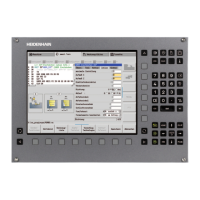January 2012 6.12 Machine Kinematics (Up to NC Software 548 328-02) 749
For machines with mutually perpendicular axes, the following results from this
convention:
The machine base coordinate system C
mb
must be selected so that its axes
are parallel to the physical axes of the machine.
If the algebraic sign of an axis is defined oppositely on the machine, then the
coordinate system of the affected axis must be rotated in the transformation
so that its Z axis points in the opposite direction.
Important rule of thumb:
The position (location and orientation) of a coordinate system is always
expressed in the coordinates of the previous coordinate system.
Example:
Position of C
Y
in coordinates of C
mb
Position of C
x
in coordinates of C
y
Position of C
mt
(machine table) in coordinates of C
X
etc.
The following are defined as well:
Tool system (C
tool
) in MP_toolCoordSystem – in addition to the
transformation sequence on the tool side
Machine table system (C
mt
) in MP_machineTableSys – in addition to the
transformation sequence on the workpiece side
The transformation sequence can also contain other systems, such as the
coordinate system of a 45× rotary axis (for horizontal/vertical spindles).
This system also represents an axis that can have the axis values 0× (vertical
position) and 180× (horizontal position). Such an axis is moved to the
appropriate position manually, via the PLC or an NC linear block.
Other coordinate systems can be auxiliary systems, which do not represent
axes, but are only used to enter the values of the relevant factors in the
kinematics chain. These systems are described as DefPoint systems. No axis
values can be assigned to these DefPoint systems (as a default, the axis
values are always null).
All axes defined in the kinematics chain must be entered in the parameter
object CfgAxes. The axes with axis values are entered in
CfgAxes/axisList and those without axis values (DefPoint systems) are
entered in MP_specCoordSysList.

